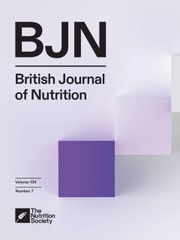Crossref Citations
This article has been cited by the following publications. This list is generated based on data provided by
Crossref.
Mahoney, Arthur W.
Hendricks, Deloy G.
Gillett, Tedford A.
Buck, Douglas R.
and
Miller, Claudia G.
1979.
Effect of Sodium Nitrite on the Bioavailability of Meat Iron for the Anemic Rat.
The Journal of Nutrition,
Vol. 109,
Issue. 12,
p.
2182.
Narins, Dorice
1980.
Biochemistry of Nonheme Iron.
p.
47.
Hazell, T.
Ledward, D.A.
Neale, R.J.
and
Root, I.C.
1981.
The role of non-haem proteins in meat haemoprotein digestion.
Meat Science,
Vol. 5,
Issue. 5,
p.
397.
Field, Ray A.
1981.
Vol. 27,
Issue. ,
p.
23.
Neale, RJ
1982.
Binding of iron by fiber of wheat and maize.
The American Journal of Clinical Nutrition,
Vol. 35,
Issue. 6,
p.
1500.
Wheby, Wheby
1982.
Reply to letter by Hazell et al.
The American Journal of Clinical Nutrition,
Vol. 36,
Issue. 1,
p.
188.
Hazell, T
Ledward, DA
and
Neale, RJ
1982.
Hemoglobin and meat iron absorption.
The American Journal of Clinical Nutrition,
Vol. 36,
Issue. 1,
p.
187.
Bogunjoko, Funke E.
Neale, R. J.
and
Ledward, D. A.
1983.
Availability of iron from chicken meat and liver given to rats.
British Journal of Nutrition,
Vol. 50,
Issue. 3,
p.
511.
Park, Y.W.
Mahoney, A.W.
Cornforth, D.P.
Collinge, S.K.
and
Hendricks, D.G.
1983.
Bioavailability to Anemic Rats of Iron from Fresh, Cooked or Nitrosylated Hemoglobin and Myoglobin.
The Journal of Nutrition,
Vol. 113,
Issue. 3,
p.
680.
HALL, G M
LEDWARD, D A
and
LAWRIE, R A
1985.
Silage from tropical fish 2. Undigested fraction.
International Journal of Food Science and Technology,
Vol. 20,
Issue. 5,
p.
573.
MACPHAIL, PATRICK
CHARLTON, ROBERT
BOTHWELL, THOMAS H.
and
BEZWODA, WERNER
1985.
Iron Fortification of Foods.
p.
55.
Latunde-Dada, G. O.
and
Neale, R. J.
1986.
Pigeon (Columba L.) meat iron solubility and availability for absorption in rats.
British Journal of Nutrition,
Vol. 55,
Issue. 2,
p.
409.
Latunde-Dada, G. O.
and
Neale, R. J.
1986.
Effect of soya-bean protein on meat iron solubility and absorption in rats.
British Journal of Nutrition,
Vol. 55,
Issue. 2,
p.
419.
LATUNDE‐DADA, G. O.
and
NEALE, R. J.
1986.
Review: Availability of iron from foods.
International Journal of Food Science & Technology,
Vol. 21,
Issue. 3,
p.
255.
Slatkavitz, CA
and
Clydesdale, FM
1988.
Solubility of inorganic iron as affected by proteolytic digestion.
The American Journal of Clinical Nutrition,
Vol. 47,
Issue. 3,
p.
487.
Rogov, Joseph A.
Kovalev, Yuri I.
Tokaev, Enver S.
and
Kaplan, Michael A.
1989.
Iron absorption from meat and meat products: Part I—Theoretical foundations for estimating available iron.
Meat Science,
Vol. 25,
Issue. 3,
p.
221.
Shears, Gillian E.
Neale, R. J.
and
Ledward, D. A.
1989.
Effects of dietary iron deficiency and tungsten supplementation on59Fe absorption and gastricretention from59Fe compounds in rats.
British Journal of Nutrition,
Vol. 61,
Issue. 3,
p.
573.
CHAMPAGNE, ELAINE T.
and
PHILLIPPY, BRIAN Q.
1989.
Effects of pH on Calcium, Zinc, and Phytate Solubilities and Complexes Following In Vitro Digestions of Soy Protein Isolate.
Journal of Food Science,
Vol. 54,
Issue. 3,
p.
587.
Ledward, D. A.
1992.
Biochemistry of Food Proteins.
p.
197.
Carpenter, Charles E.
and
Mahoney, Arthur W.
1992.
Contributions of heme and nonheme iron to human nutrition.
Critical Reviews in Food Science and Nutrition,
Vol. 31,
Issue. 4,
p.
333.

